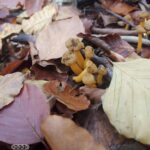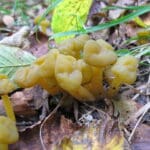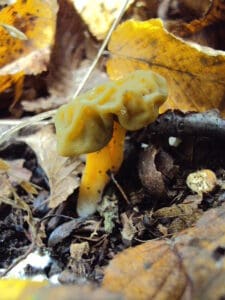Jelly Baby / Summer / Autumn / Inedible
Scientific Name
Leotia lubrica
Common Names
Jelly Baby, The lizard tuft, The ochre jelly club, The slippery cap, The gumdrop fungus, Yellow jelly babies
Family
Leotiaceae
Habitat
Found growing in woodland among moss, plant detritus or other habitats, the fruit bodies are typically found in large numbers They occur in all kinds of woodland but most commonly with conifers. While it has been conventionally regarded as a saprotroph, molecular, isotopic and other lines of evidence have suggested they are a mycorrhizal species.
Description
Commonly known as Jelly babies, these rubbery fungi look at first glance like cap-and-stem mushrooms, but beneath the irregular caps the surface is smooth rather than being gilled. Despite their common name, these little fungi are inedible, the name is due to their texture rather than their taste.
Identifying Features:
Cap:
The fruiting bodies range from 1 to 6 centimetres in height. When young they are conical in shape. When the body reaches around 2 millimetres in length, the tip of the cone begins to expand, forming the head. The heads are initially round but soon develop wavy margins. Up to 15mm across, the fertile upper surface is smooth, shiny and usually greenish brown or yellowish.
The underside is paler in colour, and smooth.
Stem:
The head is attached to a central stalk, which is around 2–8 cm tall and 3–10 mm in diameter. The stalk is typically cylindrical, but can be flattened, and occasionally has furrows. The colour is similar to that of the head, though more yellow, and the surface is covered in very small granules of a greenish colour.
Smell:
No distinctive smell.
Spores:
White.
Uses
In food
Despite their common name these fungi are inedible, due to they’re slimy texture although some guides do list them as edible.
Medicinal Uses
None known
Known hazards
No known hazards.
Potential lookalikes
A first glance they look similar to the Winter Chanterelle (Craterellus tubaeformis) but Chanterelles have ‘gills’ under the cap rather than just being a slimy blob on a stalk.
References:
https://www.first-nature.com/fungi/leotia-lubrica.php
https://en.wikipedia.org/wiki/Leotia_lubrica#cite_note-Phillips-8
https://www.mushroomexpert.com/leotia_lubrica.html
https://www.jeremybartlett.co.uk/2015/11/07/jelly-baby-fungus-leotia-lubrica/













